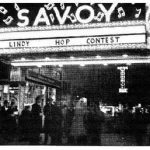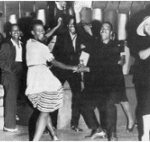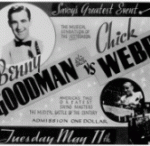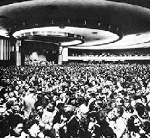A short history of the dance
A little background. Despite Puritan disapproval, there had been dancing in America since Colonial days. A very formal and rigid code of propriety governed the types of dances and the behavior of the dancers. Americans emulated the European cultural prototype, and did their best to dance and dress in the styles of Paris and London. Americans were painfully aware that Europeans considered them rough-hewn and socially unskilled. The presentation of a ball was a serious social ritual with an intricate and highly formalized etiquette. Dances consisted mostly of private balls and affairs, danced in the European tradition. The music at these dances consisted of mostly European music, methodically based and with a highly formalized structure. But with the arrival of ragtime music in the 1890’s, this formal code of dancing began to erode.
The new ragtime music was intoxicating to dance to, since it featured both a rhythmic beat and a syncopated melody. Many late Victorians found it refreshing and an electrifying reprieve from the antiquated waltzes, schottishes, and quadrilles they had grown up with. As ragtime music spread, so did the desire for dances that reflected the new and emerging styles of music. Thus, the American approach to dancing began to take serious shape at the beginning of the 20th century. A prevailing national sentiment developed that America should make a clean break with the past, be progressive and develop its own cultural identity. The lore of the American pioneers, with their independence and freedom, was popular in the press at that time. Americans grew less embarrassed about their differences from European culture, and increasingly proud of their uniqueness.
As Americans began to feel comfortable with their identity as a melting pot of diverse cultural influences, they began to question (as did some Europeans) the validity of dance forms so inescapably bound to tradition by their relatively limited form and style. As a result, American dance gradually became a synthesis of European, African, Caribbean and Latin American influences. In addition, Americans also began to emphasize creative personal expression in their dancing, along with the informal adaptation of steps from one dance into another; and innovation, creativity, and improvisation became major characteristics of American dancing.
Swing dance locates its roots and origins in the spontaneous dances of gifted improvisers to the music of Ragtime Piano, Jazz, and Dixieland, beginning roughly at the turn of the 20th century. The roots for this music is primarily in “The South”, in areas such as New Orleans, although cities such as Chicago, Kansas City and New York also played a part in the early development of swing. Given its evolution from American Jazz music, swing has deep historical roots in American music and dance history. In fact, just as Jazz is often noted as America’s most important contribution to the world of music, swing dancing has been called America’s most important contribution to the world of dance and was the first dance invented entirely by Americans.
In the 1910’s and 1920’s, the African-American community, primarily in the larger metropolitan areas, began dancing to a music form that was a synthesis of contemporary music. This included Jazz music (an expressive and rhythmic mixture of Irish and African-American music forms), Ragtime (which emphasized a lively and syncopated melody line), and the Charleston. The dance that evolved from that process later became known as the “Lindy Hop”.
Lindy Hop developed  primarily in New York City by African-Americans at the Savoy Ballroom. The Savoy Ballroom opened on March 26, 1926 in the Harlem district of New York City. Of course there were other ballrooms in New York City, the Alhambra and Roseland, among others. But the Savoy was an immediate success with its block-long dance floor and a raised double bandstand. Legend has it that in the mid 1920’s, dancers at the Savoy Ballroom were dancing the Charleston and incorporating elements from other popular dances of the day, to include the Texas Tommy, the Black Bottom and the Cakewalk.
primarily in New York City by African-Americans at the Savoy Ballroom. The Savoy Ballroom opened on March 26, 1926 in the Harlem district of New York City. Of course there were other ballrooms in New York City, the Alhambra and Roseland, among others. But the Savoy was an immediate success with its block-long dance floor and a raised double bandstand. Legend has it that in the mid 1920’s, dancers at the Savoy Ballroom were dancing the Charleston and incorporating elements from other popular dances of the day, to include the Texas Tommy, the Black Bottom and the Cakewalk.
Lindy Hop was born when dancers began using breakaways during partner Charleston dancing. This breakaway eventually became what is known as the Lindy Hop swing out or whip. The name Lindy Hop was supposedly given to this dance in 1927 at the Savoy Ballroom, in commemoration of Charles Lindbergh’s famous solo flight across the Atlantic. The first aerial or air-step was performed by Lindy Hop  Legend Frankie Manning at the Savoy Ballroom in 1935 during a dance contest. Nightly dancing at the Savoy attracted most of the best dancers, both black and white, in the New York area. Stimulated by the presence of great dancers and great bands, music at the Savoy was largely a swinging type of Jazz. Creativity mushroomed because of the diversity and a new generation of dancers emerged. Chick Webb and his orchestra were the house band at the Savoy. Their job was to hold their ground,
Legend Frankie Manning at the Savoy Ballroom in 1935 during a dance contest. Nightly dancing at the Savoy attracted most of the best dancers, both black and white, in the New York area. Stimulated by the presence of great dancers and great bands, music at the Savoy was largely a swinging type of Jazz. Creativity mushroomed because of the diversity and a new generation of dancers emerged. Chick Webb and his orchestra were the house band at the Savoy. Their job was to hold their ground,  as bands came to the Savoy to square off in “The Battle of the Bands”, where each band would do their best to outdo the other. The dancers did their best to keep up with their lightening tempos and intricate solos. At Saturday night competitions, the dancers competed with each other throughout the night, inspiring even greater creativity and energy.
as bands came to the Savoy to square off in “The Battle of the Bands”, where each band would do their best to outdo the other. The dancers did their best to keep up with their lightening tempos and intricate solos. At Saturday night competitions, the dancers competed with each other throughout the night, inspiring even greater creativity and energy.
Lindy Hop quickly began to spread all over the U.S. (and overseas as G.I.s took it to Europe during World War II), influencing and reflecting the developemnt of many regional styles of swing dance. By the late 1930’s and through the 1940’s, the terms Lindy Hop, Jitterbug and Swing were used interchangeably by the news media to describe the Lindy Hop style of swing dancing taking place on  the streets, in the night clubs, in contests and in the movies. The August 23rd, 1943 edition of Life Magazine even declared the Lindy Hop as the “national dance”. (Mike and Mary have a copy of this edition of Life Magazine if you would care to view it.) With influences that originated in the Charleston, traditional West African dance styles, and a variety of European social dances, the Lindy Hop included not only partner dancing, but also individual solos and line dancing.
the streets, in the night clubs, in contests and in the movies. The August 23rd, 1943 edition of Life Magazine even declared the Lindy Hop as the “national dance”. (Mike and Mary have a copy of this edition of Life Magazine if you would care to view it.) With influences that originated in the Charleston, traditional West African dance styles, and a variety of European social dances, the Lindy Hop included not only partner dancing, but also individual solos and line dancing.
As the grandfather of all swing dances, Lindy Hop eventually evolved into some other variations, to include what is called West Coast Swing, Boogie Woogie, etc. But like many things in life, the original is still the best! While the dance that evolved during the swing-era is known as Lindy Hop, it should be remembered that during the early development of swing dancing, there were probably other different styles of now unnamed and undocumented swing dance. With all the creative talent in the Savoy Ballroom, one would not expect to find a homogeneity of style on a 4,000-capacity dance floor, but instead, combinations of various contemporary popular dances.
With the end of World War II, jazz music began to change as Bebop (and other forms of non-swinging jazz music) and rock and roll began to emerge. Chubby Checkers’ song “The Twist” generally killed off partner dancing in the early 1960’s. In fairness, swing was not the only dance that suffered a decline. Much of the music of the 1960’s and 70’s was geared toward sitting and listening, not tapping your toe and getting up and dancing. This was also a period of “do your own thing”, an attitude not conducive to partnered social dancing. Throughout the 1960’s and 70’s, swing music was kept alive by members of the original “Big Band” generation. However, swing music itself was often marginalized in late night record offers and commercials. To many members of the baby-boom and later generations, swing music was often equated with the stale music of a Guy Lombardo New Year’s eve celebration, or even the “champagne” music of Lawrence Welk. Ugh!
Swing dancing was taught at ballroom dance studios in the 1960’s and 70’s, but much like swing music in the mass media, it was a marginalized, watered-down version that was taught, not the original Lindy Hop. Depending on the particular region of the country, the ballroom version of swing was often called “East Coast Swing” or “West Coast Swing”, with emphasis on rigid patterns and steps, and little or no emphasis on improvisation, innovation or dancing to the music. The Hustle or Disco movement of the 1970’s was a factor in bringing the concept of partner dancing back to the general public, with a resulting rise and interest in partner dancing in general. (Disco and Hustle had a major influence on the development of West Coast Swing to the point that this style of swing dance has lost any of it’s Lindy Hop flavor and styling.) The 1980’s witnessed a number of singers, to include Harry Connick, Jr., Linda Rondstadt and Bette Midler recording several Big Band era classic songs. The 80’s also witnessed a renewed interest in learning partnered dances by young adults who were seeking something new and different. Many of these youths were increasingly disenchanted with hard rock music and its emphasis on the heavy metal, grunge musical movement and the formless, nihilistic, booty-shaking dancing that left each partner in their own, lonely bubble.
There was a “Rockabilly Revival” in the 1980’s, as a number of bands dedicated to replicating the style and sound of the classic 1950’s rock and roll emerged. As some of these bands (and some punk rock bands) further explored the roots of rockabilly and 1950’s music, they learned about Jump Blues and Big Band music and began to form the so-called neo-swing bands, as witnessed by Royal Crown Revue, probably the pioneer band of the swing revival, formed in Los Angeles, California in 1989. It was in the early 1980’s that Lindy Hop began to re-emerge. Dancers in New York City, California and Sweden sought out the original Lindy Hoppers. Many of these dancers traveled to New York to study with some of the original Lindy Hoppers: Al Minns, Pepsi Bethel, Frankie Manning and Norma Miller. Frankie Manning in particular came out of retirement and began teaching Lindy Hop and the history and culture of the dance at workshops and swing dance events world wide. In the United States, the emerging “neo swing” scene in the 1990’s was concentrated in California, primarily San Francisco and then Los Angeles. But a series of events, to include the 1993 film Swing Kids, the 1994 film The Mask, the 1996 film Swingers and the 1998 “Khakis Swing” GAP TV commercial (shown in the highly rated finales of “ER” and “Seinfield”) that featured Louis Prima’s song “Jump, Jive ‘n’ Wail” brought the swing revival temporarily into the mainstream.
As the “neo swing” revival faded towards the end of the 1990’s, the overall number of dancers decreased but the more devoted followers of the dance began to research the history of the dance; seek out the original swing dancers and vintage video for inspiration; and move away from “neo swing” music to the original music of the swing-era. The traditional sytle of Lindy Hop is now dance all over the world, with active Lindy Hop in many major metropolitan areas, but also in smaller cities. The dance continues to grow as scholarship and research about the dance also grows.
Technical aspects of the dance. Defining Lindy Hop from a technical can be difficult, because Lindy Hop is not primarily defined by counts, stylings, moves or patterns. Lindy Hop is defined by the music, and the music defines Lindy Hop. Indeed, Lindy Hop is all about dancing to the music. As the original swing dance, Lindy Hop is not based on imitation but on creation. Lindy Hop is best thought of as a creative, energetic, free-spirited partnered dance. But any art form needs a frame of reference in order to provide a technical context, so here goes.
Technically, the Lindy Hop has an 8 count basic step: 1,2 (normally step, step for the follower); 3and4 (triple step); 5,6 (step, step); 7and8 (triple step). Lindy Hop consists primarily of 8 count patterns, but is a versatile dance that can easily incorporate 6 count patterns. Lindy Hop is often defined by it’s “swing out ” or “whip” type basic pattern. For its basic patterns, the dancers’ “frame” in Lindy Hop is more of a rectangular and elongated shape, given that the leader and follower often spin simultaneously on an axis. This axis also tends to stay more in one place and not move around the floor. If the dancers are offset (i.e. looking over each other’s shoulders), the frame can easily collapse due to uneven weight distribution.
Stylistically, Lindy Hop is danced using a low, loose-legged posture, a low center of gravity, with bent and elastic knees. Various kicks and Charleston type patterns are often incorporated into the Lindy Hop. An attractive and key feature of the Lindy Hop as a partner dance is that it includes the flexibility for freedom of musical expression, creativity, innovation and improvisation, not only as a partner dance, but also for individual solos. Lindy Hop is probably the most advanced form of swing dancing from the perspective of the “lead and follow” skills and techniques necessary for musical expression. Lindy Hop is one of the few partner dances that allows the lead and follow the freedom to stylize movements within the framework of the musical phrasing. This freedom is very attractive to dance partners once they progress beyond the basic level of experience and expertise.
Utilizing intermediate and advanced “lead and follow” skills and techniques, movements in Lindy Hop are best done in relation to the music. The lead “feels” the music and creates for the follow an environment with which she can use improvisation and creativity to manage her movements, but at the same time employing good follow techniques. This is a somewhat hard concept to “master” given that one never totally masters “lead and/or follow” skills and techniques, but merely obtains additional experience. But the rewards are tremendous for those that try and achieve any level of success!
Out of town opportunities to learn Lindy Hop. Listed below are a few national/regional level Lindy Hop weekend workshop type events that Mary and I have either attended or heard good things about the event from other Lindy Hoppers. Some Lindy Hop events may also have classes and maybe even competitions for Balboa, perhaps Collegiate Shag, i.e. Camp Hollywood.
As expected, a lot less events on the calendar, as compared to pre-pandemic times; and some events have not re-started. Check out the Hepcats calendar page for updates; and the Swing Planit web site for world-wide Lindy Hop and Balboa events.
Info provided below only as a service to web users; no other info expressed or implied. See the event web site and/or contact the event for full details.
- Camp Hollywood, Los Angeles, CA.
- Lindy Focus, Asheville, NC.
- International Lindy Hop Championships (ILHC).
- Swing Out New Hampshire.
- SwingIN, Indianapolis, IN.
- Dayton Swing Smackdown.
- Rocktober, Columbus, OH.
- Nevermore Jazz Ball, St. Louis, MO.
- American Lindy Hop Championships (ALHC).
Caution – Caveat emptor! Hyperbole is rampant and commonplace these days, especially in swing dance event promotion on FB, on event web sites, etc. Words and phrases like “awesome”, “amazing”, “fantastic”, “coolest ever”, “legendary”, “fabulous”, “incredible”, “super amazing”…… are so vastly overused those words have almost lost any meaning. I’ve seen swing dance event web sites (and FB pages) that describe their event as having “world class instructors”, or “incredible bands”, when what they had were perhaps some good regional instructors, and a nice band, but certainly nothing that should be described as “world class” or “incredible” or “amazing”…….. It can be a real challenge separating fact from fiction in swing dance event promotion – – so buyer beware!